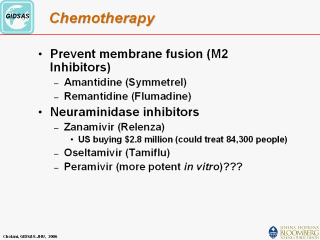| front |1 |2 |3 |4 |5 |6 |7 |8 |9 |10 |11 |12 |13 |14 |15 |16 |17 |18 |19 |20 |21 |22 |23 |24 |25 |26 |27 |28 |29 |30 |31 |32 |33 |34 |35 |36 |37 |review |
 |
The M2 inhibitors: Amantadine and rimantadine, could potentially be used against pandemic influenza, but resistance to these drugs can develop rapidly and this could significantly limit their effectiveness against pandemic influenza. Some currently circulating H5N1 strains are fully resistant to these the M2 inhibitors. However, should a new virus emerge through reassortment, the M2 inhibitors might be effective. Neuraminidase (NA) inhibitors: Oseltamivir (commercially known as Tamiflu) and zanamivir (commercially known as Relenza) can reduce the severity and duration of illness caused by seasonal influenza. The efficacy of the NA inhibitors depends, among others, on their early administration (within 48 hours after symptom onset). For cases of human infection with H5N1, the drugs may improve prospects of survival, if administered early, but clinical data are limited. The H5N1 virus is expected to be susceptible to the NA inhibitors. Antiviral resistance to NA inhibitors has been clinically negligible so far but is likely to be detected during widespread use during a pandemic. A new NA inhibitor peramivir has shown potential in vitro studies. |